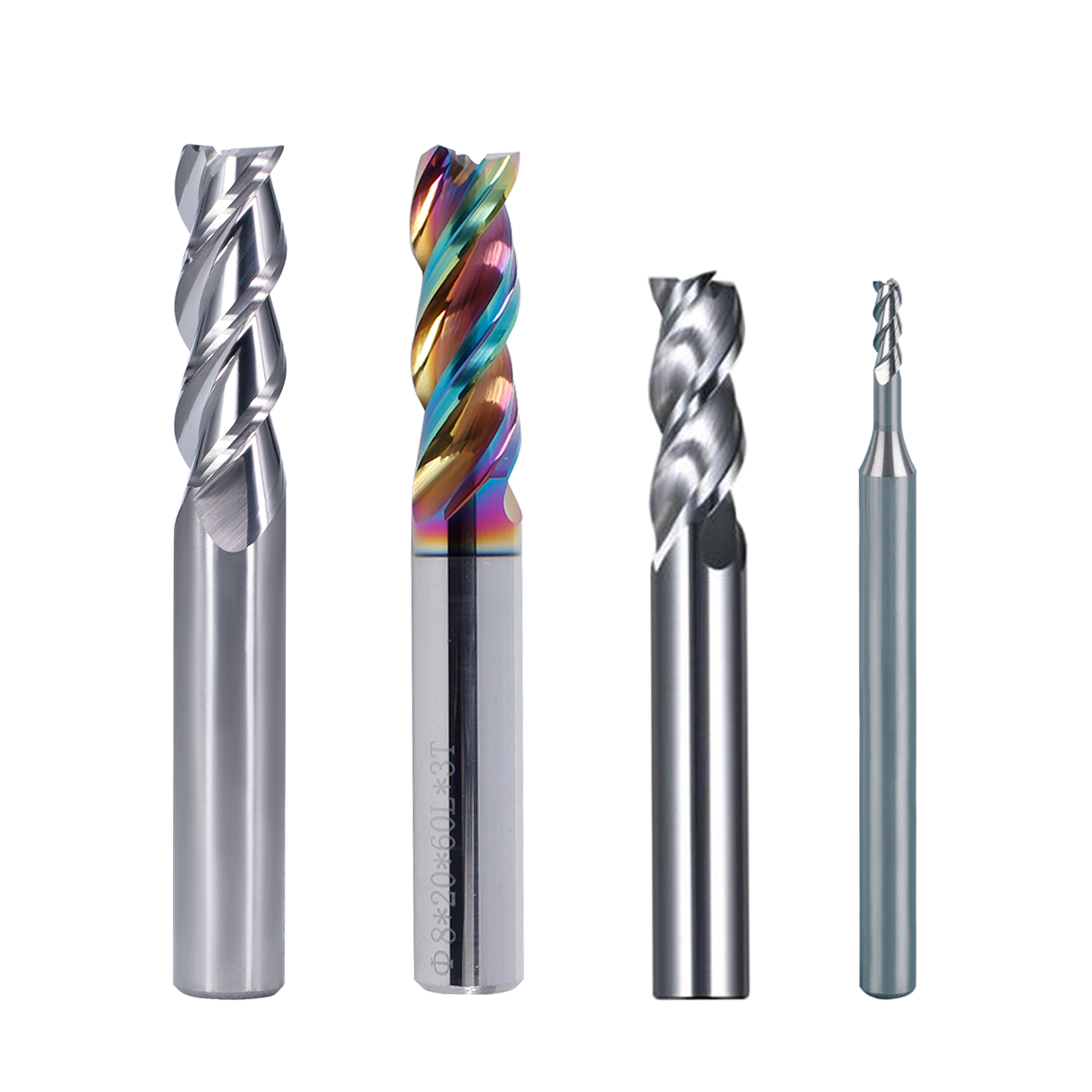One of our European customers, a machinist, used to produce aerospace machine parts using ordinary milling cutters. But after shifting to high-efficiency milling cutters, his processing capacity increased by 1.5 times in one day.
How did this happen? What are high-efficiency milling cutters? What is so different about them? Read on as I answer all these questions.
High-efficiency milling cutters such as solid carbide endmills have a more significant number of flutes with a reliable and heavy core. They serve as tools for high-efficiency milling processes. In this technique, these milling cutters run at high speeds with a lower RDOC (Radial Depth of Cut) and a higher ADOC (Axial Depth of Cut), distributing the heat evenly across the cutter.
Although both high-efficiency and ordinary milling cutters perform milling operations, there is a significant difference between them. High-efficiency milling cutters differ from ordinary ones in terms of how they are built and used during processing. Let’s review their differences under five categories.
- Axial Depth of Cut or ADOC.
- Radial Depth of Cut or RDOC.
- Heat dissipation
- Axial and radial passes
- Material Removal Rate or MRR
Axial Depth Of Cut
Axial Depth of Cut or ADOC is the distance milling cutters engage a workpiece along their axis or centerline. High-efficiency milling cutters have a higher axial depth of cut, while ordinary milling cutters have a lower axial depth of cut.
Radial Depth Of Cut
Radial Depth of Cut or RDOC is the depth of milling cutters along their radius in the workpiece as they cut.
High-efficiency milling cutters have a lower radial depth of cut, while ordinary milling cutters have a higher radial depth of cut.
Axial And Radial Passes
High-efficiency milling cutters take more radial passes on their workpiece, using the entire flute to make a more minor yet deep cut. Standard milling cutters, on the other hand, take more axial passes. They start at the top and work their way down into the workpiece, taking a massive cut at the bottom.
The differences in axial depth of cut, radial depth of cut, and the direction of passes bring about differences in heat dissipation while cutting the workpiece.
Heat Dissipation
When you work with high-efficiency milling cutters, the wear dissipates heat in all directions. However, in ordinary milling cutters, the heat concentrates in the lower portion of the tool.
Material Removal Rate
The Material Removal Rate or MRR measures cubic inches of material removed during the milling application in one minute. You can calculate it by multiplying three factors with each other: Axial Depth of Cut (ADOC), Radial Depth of Cut (RDOC), your feed per minute (feed rate).
High-efficiency milling cutters have a higher MMR with an increased feed rate, while ordinary milling cutters work at a relatively lower MMR with a conservative feed rate.
Benefits of High-efficiency Milling Cutters in the Machining Process
High-efficiency milling cutters benefit machinists during different machining processes in the following five ways:
- High metal removal rate
- Increased roughing efficiency
- Prolonged tool life
- Low production costs
- Reliability and security
High metal removal rate (MRR)
You can achieve high metal removal rates by using high-efficiency milling cutters as the cut width (radial depth of cut) is reduced from 50% of the cutter diameter.
Increased Roughing Efficiency
Small stepovers, faster feed rates, and deeper depths of cut, all contribute to the increased roughing efficiency of these milling cutters without compromising the tool life.
Prolonged Tool Life
The structural and functional features of high-efficiency milling cutters that prolong their tool life include a higher number of flutes and their engagement with the workpiece for a short time. It generates less heat as the stress from all the workpiece cutting distributes evenly across the entire tool.
Low Production Costs
High-efficiency milling cutters allow machinists to maximize their output with prolonged tool life, reducing the production cost.
Reliability and Security
Using high-efficiency milling cutters in the machining process adds to the process reliability and security.
Luke Pollock, product manager at Walter USA, says, “Because of only using light radial engagement of the tool, and a program maintaining a constant TEA, the tool is never in a situation where there is a chance of becoming over-engaged or at risk of packing chips. The machining condition stays consistent, providing consistent tool life and minimal risk of having a crash or tool breakage situation.”
Examples Of High-efficiency Milling Cutters
Carbide Corner Radius Endmills
Corner radius end mills, also called bull end mills, are typically made of carbide steel. They are less vulnerable to chipping and therefore have a long tool life. Many variants exist in the market in terms of the flute count and helix angle configuration.
Machinists use these single-ended cutting tools to extend the corner arc and form a complete circle on the workpiece. They also use them to remove sharp, raised bits of metal, giving a smooth finish.
Carbide Square Endmills
Carbide Square Endmills, also known as flat end mills, have sharp corners that work at 90° angle. Endmill manufacturers usually make them in various diameters using high-speed steel such as carbide. Unlike corner radius endmills, they can be both single and double-ended cutters.
Square end milling cutters come in handy for the following processes:
- Plunging
- Grooving
- Side milling
- Face milling
- Counter boring
Ball Nose End Mills
Ball nose end mills or ball end mills have a round, hemispherical cutting edge. In the case of milling block materials, the optimum inclined angle is 15° for ball-milling processes.
According to Schulz and Hock, the reverse cut with a tool inclination in the range of 10° to 20° is the ideal machining strategy for high-speed milling in the mold and die-making industry.
Uses of ball end mills include:
- Contouring or 3D semi-finishing of dies and moulds
- Profiling
- Slotting
- Pocketing
- Corner picking
What Are The Precautions During The Use Of High-efficiency Milling Cutters?
- Stop the milling machine before setting up high-efficiency milling cutters or replacing the workpiece.
- Use a wiping cloth to remove all the chips from the high-efficiency cutter. So you don’t hurt your hands.
- Ensure that the teeth of high-efficiency cutters are sharp. If they appear dull, sharpen them using the cutter grinder.
- If there are burrs in the milling cutter, remove them using an abrasive stone.
- Store all your high-efficiency milling cutters on a rack. So they don’t bump into each other.
- Keep the environment cool while working with milling cutters and their workpieces.
- Set the feed rate according to the workpiece material and the size and flute count of the milling cutter.
- Consult your tech team before using any variation of the high-efficiency milling cutter for any material.
High-efficiency milling or HEM is making rounds in the medical, automotive, and aerospace industries because it boosts the speed and feed rate of the machining process with much higher material removal rates (MRR), reducing the cutting time to 50-70%.
In this technique, machinists take more radial passes with a wide axial and smaller radial, making deep cuts. Due to this, the heat energy spreads over the entire cutting edge instead of concentrating in the lower portion of the milling cutter. It decreases the chances of tool failure and makes the process more productive, saving you the extra cost of tool renewal.
The milling cutters that work with this roughing technique come in various geometric shapes. They cut through stainless steel, cast iron, titanium alloys, high-temperature alloys, and super alloys.



